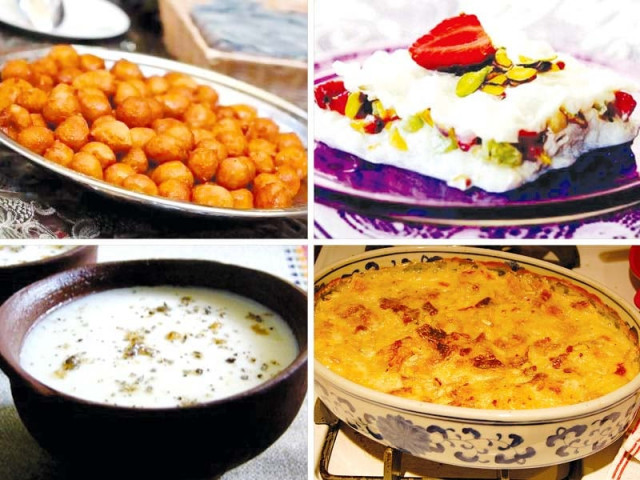Traditional sweetmeats from around the world
Nine dessert delicacies that are definitely worth the cavities

DESIGN MARYAM RASHID
Turkey

According to Yasmin Beygo, a student from the city of Marmaris, “Women in Turkish households often wake up early on Eid mornings to prepare Kunefe, Sekerpare and Gullac — the most popular of Turkish desserts.” Much like Pakistanis, the Turkish also distribute these sweets to the public and friends or family during Eid and otherwise as well. “In fact, it is considered extremely rude here to resist the gift of sweets,” says Yasmin. “And if a person is unable to prepare good Gullac, it becomes an insult!”
• Kunefe: This cheesy pastry is extremely popular in the Hatay region of Turkey and around the town of Antalya. It comprises of two special ingredients, first being Tel Kadayif — a dough spun on hot spinning tables to create long strands. The strands are cut short before cooking. The other ingredient is Hatay cheese, Turkey’s equivalent of mozzarella, made with fresh milk. Kunefe is served warm, along with ice-cream or clotted cream.
• Sekerpare: Pronounced as ‘Sheh-ker-pah-re,’ the world literally translates to ‘pieces of sweetness’. These stick and soft cookies comprise of semolina, flour and powdered sugar, baked and dipped in sweet lemon syrup.
• Gullac: A white, fluffy and milky dessert, Gullac contains layers of paper-thin cornstarch soaked in sweet milk and flavoured with rose water. It is usually garnished with pomegranate seeds and nuts. Gullac also happens to be ancient delicacy, said to have been conjured in the early Ottoman times.
Iran

“It’s tradition for Iranians to exchange sweets and cocoa milk after Eid prayers,” says Zohre Faz, a teacher from Qazvin in western Iran. “Elders often gift sweets and money to youngsters who visit them.” According to Zohre, different regions of the country follow different traditions in terms of the desserts they prepare. Northerners make Naan Barenji while most of western Iran prepares Nan-e-Nokhodchi. Baklava, however, remains the most popular across all of Iran.
• Naan Barenji: This classic Persian dish includes rice flour, a type of flour produced from finely-milled rice grains. It is distinctly sweet, featuring a dash of rose water and cardamom.
• Nan-e-Nokhodchi: Flavoured with cardamom and pistachios, Nan-e-Nokhodchi is a biscuit made from chickpeas.
• Baklava: A world-renowned Mediterranean treat, Baklava is made from Phyllo dough, butter and sugar. Once baked, sweet syrup is poured over the sweets so that it is absorbed. Legend has it that Baklava hails from Assyrian origins, baked on special occasions by the rich of that time. It is now common across the Middle East.
Oman

Eid in Oman is characterised by elaborate feasts where the desserts always shine. Once again, according to 22-year-old Manaf Fadhil, “It is traditional for women to prepare them at home early in the mornings, although most of the eatables are available in shops.”
• Luqemiat: In Oman and other Gulf nations, the Luqemiat is made from flour, dry yeast, saffron and cardamom. The dumpling itself isn’t sweet so honey or sugar syrup is added on top. Interestingly, the Egyptians, Lebanese, Syrians and Jordanians call it Luqmat al Kadhi and prepare it in a different way from the Omanis.
Saudi Arabia

The Saudis are known to go all out on Eid. The celebrations fluctuate culturally, depending on which part of the country you might be in, but Saudi generousity and hospitality stands out throughout. In fact, according to housewife Hiba Al Busaidi, it is customary for Saudi families to congregate in one place and break bread together.
• Umm Ali: The story behind this dish is rather disturbing! Om Ali was the wife of an Ayyubid ruler from Egypt called Ezz El-Din Aybek. After his death, his second wife Shagaret El Dorr — who was Om Ali’s arch rival — had the latter murdered and to celebrate, she requested cooks from the region to concoct the most delicious desserts they could think of. The winning recipe was a pastry with milk and honey, named after Om Ali and distributed throughout Egypt along with a gold coin. Now, the original recipe has been tweaked and includes condensed milk and nuts, frequently eaten with vanilla ice cream.
Bangladesh

PHOTO: CRAVEBITS.COM
Did you know that it is customary to serve only milk-based sweets on Eid in Bangladesh? “On Eid, Bengalis visit one another’s house specifically to taste the sweets that have been prepared,” informs Dhaka-based student and chef Parsa Atora. It is a source of great pride to cook and serve the best sweetmeats in the family.
• Mishti Doi: This sweet yogurt is cooked with milk and caramelised sugar in earthenware pots so that the gradual evaporation of water thickens its consistency. Often, Bengalis season the yogurt with elaichi for a pleasant fragrance.
• Shemai: In Bangladesh, sheer korma is known as Dudh Shemai, ie milk vermicelli. It is commonly served as breakfast at home following Eid prayers and can be eaten warm or cold. Some prefer the creamy, milky form of Shemai while others like it dry. Another popular variation of Shemai is the Zarda Shemai which is essentially, fried vermicelli.
• Payesh: This is a milk-based concoction somewhat like kheer. It can be prepared using milk or paneer and flavoured with nuts as well. Fresh or dried coconut, as well as coconut water, is used to add more flavour and texture to Payesh.
Hurmat Majid is a subeditor at The Express Tribune. She tweets @bhandprogramme
Published in The Express Tribune, Ms T, July 19th, 2015.



















COMMENTS
Comments are moderated and generally will be posted if they are on-topic and not abusive.
For more information, please see our Comments FAQ